Alex Herrera examines the most powerful deskside workstation we’ve ever tested.
By Alex Herrera
Let’s make it clear right off the bat: the Lenovo ThinkStation P900—especially the way it’s configured—is not for everyone. That’s not to say the majority of professionals wouldn’t want one; the price tag will scare off the vast majority of buyers. However, at $18,156 this newest ThinkStation is an incredible machine for professional-caliber visual computing.
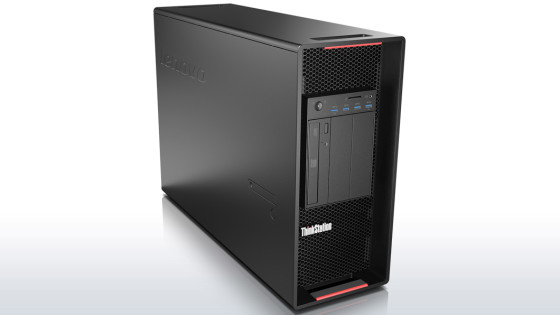
Yes, there’s the obvious angle of performance to consider with this machine, and after perusing our build specs, we had little doubt it would set records (in our database) for benchmarks. So there was little surprise that it did—and not by a small margin either. But what impressed more, perhaps, was the quality and thoroughness of Lenovo’s engineering of the P900. A clear reflection of the company’s deliberate, renewed focus on the workstation market, the design of this machine leaves no detail unaddressed.

An accidental manufacturer
Lenovo started in workstations somewhat by accident. Unlike its rivals, HP and Dell, each with much longer histories in workstations, Lenovo more or less backed into the market. Inheriting the ThinkPad -P line in the acquisition of IBM’s PC business in 2005, Lenovo overnight became the industry leader in mobile workstations. However, it wasn’t clear the company considered workstations a strategic business until 2007, when it made a more deliberate move into the space with a line of deskside workstations. That initial workstation family helped the company gain market share, and by mid-2014 it captured about 12% of the worldwide market.
With Lenovo appearing more bullish on workstations, and in light of its two rivals’ major investments and product re-designs, we’d been expecting to see Lenovo make a significant move in the space. Sure enough, in 2014, we saw Lenovo invest significantly in workstations with a top-to-bottom, deskside product line overhaul. In August 2014, the company launched four new models, retiring the S-, C-, and D- prefixes with a unified “P-” prefix brand: the P300 is its new entry model; the P500 is the premium single-socket model; the P700 is the compact, economy dual-socket model; and the P900 is the no-compromise, top-end, dual-socket machine.
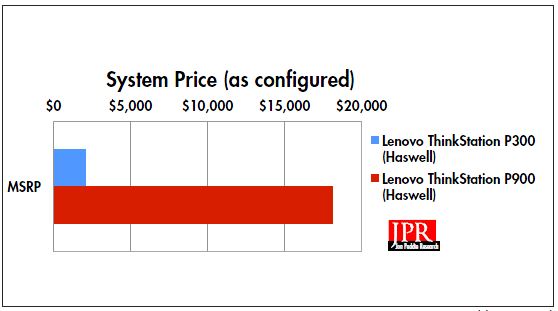
Last fall, we got a chance to review the first of the four that shipped in volume, the entry P300. Now, it’s time to check out the other end of Lenovo’s new line—the top end—with a look at the premium, dual-socket P900 tower.
We expected with a bigger budget at the high end, Lenovo could do some valuable and innovative things—and they did. As its rivals did in their respective workstation line renaissances, Lenovo re-engineered the chassis, improving the aesthetics, ergonomics, and cooling (and therefore noise and reliability as well).
Leaving nothing out
Lenovo added the now industry-ubiquitous integrated handles, which for this 52-pound P900 is less a nicety and more a necessity. With its signature honeycomb grill, the P900 exterior shares the same look-and-feel as the rest of the new P-series family.
This machine oozes performance no matter where you look. Let’s start with the CPUs. Not only did Lenovo fill both sockets with the latest Haswell-E Xeon E5- 2600 v3 series processors, but of the many possible E5-2600 v3 SKUs, the company picked the highest-performing part: the E5-2687W v3. The “W” suffix indicates that the processor is for workstations, rather than servers (where the bulk of Xeons end up). With Xeon straddling servers and clients, Intel creates some SKUs more oriented to the former (with lower clock rates and more cores) and some more oriented to the latter. But that doesn’t mean all workstations have a “W” suffix part, as only one SKU in the E5-2600 v3 family (out of more than 30 SKUs) does, and it’s one of the most expensive ones. The E5- 2687W v3 strikes a balance of taking on a multitude of cores (10), without sacrificing a high clock rate (3.1 GHz) necessary to churn through single-threaded applications.
Then there’s the 112 GB of 2033- MHz DDR4 memory, the PCI Express-based SSD, and Nvidia’s second most powerful Quadro K5200 GPU. Combine them, and you’d be hard pressed to find any major component to complain about.
Tool-less access to ample and flexible components
Tool-less is now a check-mark item for workstations; all top-tier vendors are making it a priority. With its premium price allowing for more generous attention to design, the P900’s intuitive and modular access of internal components reflects a no-stone-unturned approach to the tool-less workstation. Red-coded tabs throughout the chassis guide fingers looking to attend to pretty much every component inside: air cowl, add-in cards, fans, power supply, storage bays, and the company’s new Flex Connectors (described below). We had each of the aforementioned items removed from the system in a matter seconds.
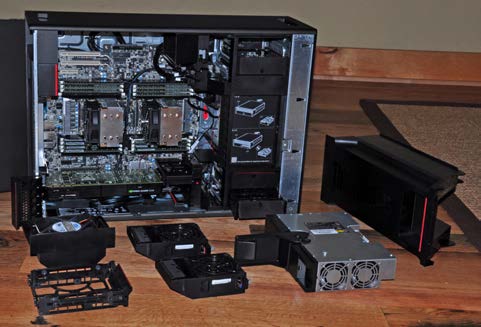
Lenovo’s most notable differentiator came in the area of slot and bay flexibility. With the new P-series, the company unveiled its Flex technology, which consists of a few components designed to make available space and I/O accommodate as many different combinations of devices possible per user requirements. A Flex Bay, for example, can accommodate not only the typical optical drive, but also an ultra-slim drive, a media card reader, or Firewire. A Flex Tray can populate both 2.5-inch and 3.5-inch drives, one of the latter or two of the former. Capable of housing seven Flex trays, the P900 can boast support for 14 drives.
And the third component, the Flex Connector, is an optional “mezzanine” daughter card that can sit directly on the motherboard to provide SATA, SAS, or PCIe storage without taking up the physical space of longer PCIe slots. Our build came with a Flex Connector card containing a 256-GB PCIe SSD, situated at the rear of the PCI Express slots, with a clever retention mechanism that also fastens down the tail end of the long Quadro K5200 card.
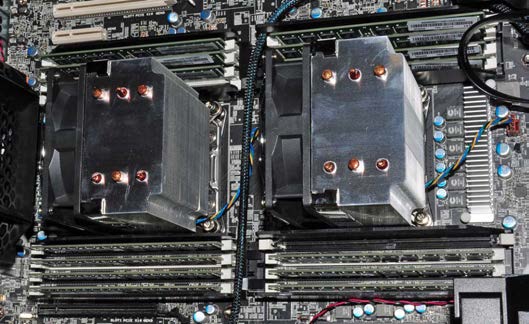
In pursuit of higher reliability, lower power, and lower noise, engineers reworked airflow via “Tri Channel” cooling, which the company claims both simplifies and enhances airflow efficiency. The Tri Channel Cooling should improve both reliability (cooler components are less likely to fail) and acoustics (reduced fan speeds per thermal output). We can’t comment on reliability, but for a machine with this kind of power footprint, noise was not a factor. Probably the best statement on its acoustic output was the fact that we didn’t even think about noise until it came to writing up the review and suddenly realized we’d never noticed it.
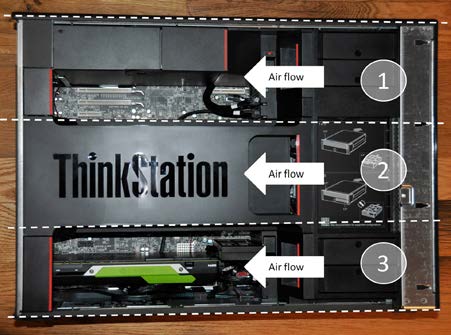
With two CPUs, all that memory, and support for multiple high-power GPU cards, the P900 isn’t going to be equipped with a typical desktop-caliber power supply unit (PSU). Rather, the PSU is capable of putting out as many watts as any client-side machine—1300 W—and it does so extremely efficiently. On the standard 80 Plus rating system, this unit gets a Platinum grade. Superior to Bronze (85% efficient at 50% load), Silver (88%), and Gold (90%), this PSU can turn 92% of line power into the 12V and 5V rails system components require. Higher efficiency means lower thermal output, which again contributes to cooler, quieter, and more reliable operation.
The P900’s plentiful array of I/O ports is unlikely to disappoint. The front panel sports four USB 3.0 ports and an integrated 9-in-1 SD card reader, while the rear offers another four USB 3.0 ports, four USB 2.0 ports, and two Gigabit Ethernet ports to go with some legacy PS/2 and standard analog audio ports. The only omission worth nothing is Thunderbolt, but its appeal is still limited in most workstation applications (as opposed to the Mac space, where it is essential).
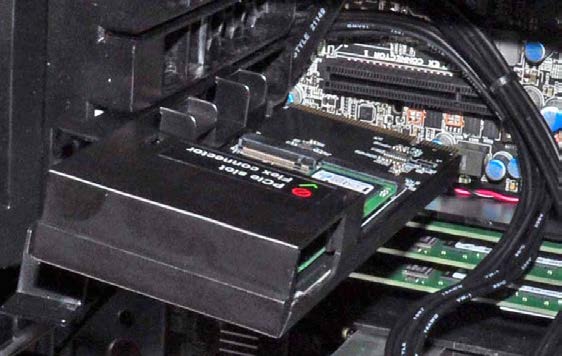
Benchmarking the ThinkStation P900
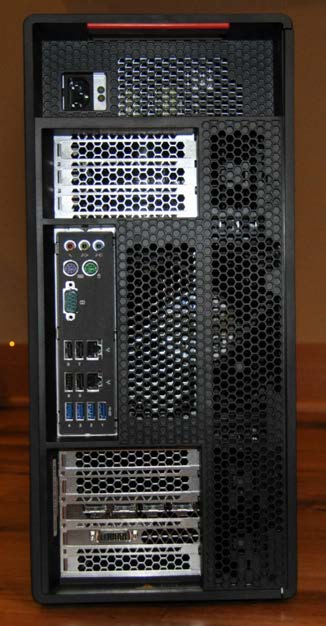
Whenever we benchmark a system, we look for opportunities to do comparisons with similar systems we’ve tested recently, and most often by “similar,” we mean similarly priced. We often see hardware reviews that rave about the capabilities and performance of one machine while criticizing another, only to discover that the former costs a lot more than the latter … a practice neither fair nor useful.
Hardware engineering and product design is about balancing features and performance with the bill of materials, and ultimately, the only fair, apples-to-apples way to compare two different workstations is to compare dollars to dollars. And that leads to the problem we had with this review: we haven’t had a machine with a price tag anywhere near that of our P900 for some time, making any kind of apples-to-apples comparison impossible.
But in such cases, what we instead find revealing is to demonstrate how performance scales with price within a product line. And that’s an exercise we could perform, because we’d recently benchmarked a machine at the exact opposite end of Lenovo’s product line, the economical, entry-class ThinkStation P300. At $2,068, that P300 was a far cry from our $18,156 P900, creating an opportunity to assess how much more performance many more dollars can buy.
The P900’s head-and-shoulders superiority over the P300 is reflected in virtually every hardware category, from CPU (20 cores versus 4), to storage (SSD versus HDD), to GPU (Nvidia Quadro K5200 versus K4200). But far and away the biggest discrepancy in the two machines was memory, with our P900’s 112GB dwarfing the P300’s 8GB.
We tested both machines with SPEC. org’s SPECwpc benchmark suite. SPECwpc’s whole-system testing gives a clearer idea of how the fully configured system will perform, considering the entire workload, including application, graphics, memory, OS, I/O, etc. It’s designed to be comprehensive, comprising separate suites, one per each of six verticals, including Media and Entertainment, Product Development, Energy, Life Sciences, Financial Services, and General Operations. Each suite includes anywhere from five to nine workloads, relevant to those specific spaces. The benchmark reports a composite score, aggregating sub-test results, for each of the six application suites.
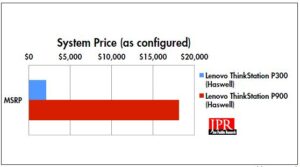
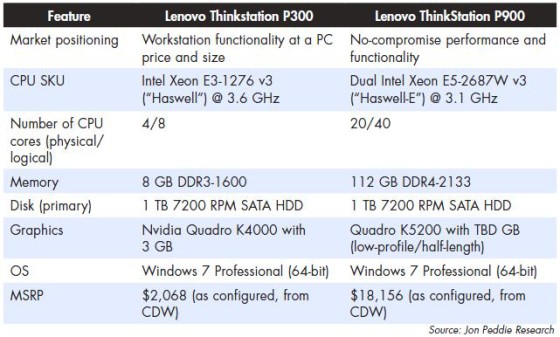
Two conclusions quickly arose. First, the P900, as expected, delivered the best SPECwpc scores we’ve seen to date. Second, those scores crushed those of the P300 by a wide margin. Both conclusions were not only obvious but justified, given the disparity in builds and resulting price tags.
What’s more interesting to look at is the relative price-performance—the scores-per-dollar of the two systems. And there we see the reverse, with price/performance favoring the lower-cost machine, a typical and sensible result that reflects diminishing returns as the price climbs. How much did the return diminish? Well, if we average out the SPECwpc composite scores, we find that a machine with nine times the price yielded about three times the performance. To some that may seem a poor return, but in reality, getting 3X performance for 9X the price is reasonable, and well within the norms of what one might expect in the context of computing. One never sees a linear relationship in gained performance with higher prices, and the further up the performance curve, the harder it is to return anything close to it.
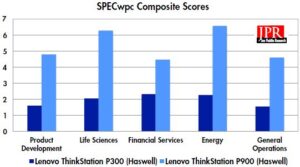
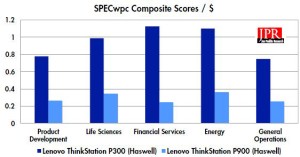
What do we think?
Lenovo is past the workstation learning curve. Whether it originally entered the market by intent or not, the company has learned what it takes to compete. As evidence, we’re seeing Lenovo up its interest and investment in comprehensive engineering and marketing to keep up with main competitors, Dell and HP. It knew it needed to match the market leaders’ level of commitment, and with the recent launch of the new ThinkStation P series, it has.
The new P series integrates the same core components from Intel and Nvidia that its rivals rely on. And it’s made many of the same enhancements to the chassis design, like optimal cooling, ergonomics, and minimal noise. In terms of well-thought-out, well-engineered design, the P series more than holds its own, and our P900 is a showcase for the company’s efforts. The attention to detail on robustness and serviceability is impressive, to the point that we can’t imagine anyone being disappointed with any aspect of the design. Of course, one can argue a machine priced at $18K shouldn’t disappoint in any aspect, and that may be true.
And that leads to the obvious question … how many prospective buyers are we really talking about here who would be willing to cough up a dollar figure almost 10X the average selling price of today’s workstations ($1,938 in Q3’14, by JPR records)? This is one of those instances where the cliché applies: if you have to ask, you can’t afford it. If you’re shopping for a machine configured like this, capable of this kind of performance, you don’t care about price. And we don’t mean that figuratively, but literally.
Machines like this are employed by businesses and professionals for which any substantial increase in productivity is both desired and rewarded, and it doesn’t matter whether the machine costs $2,000 or $20,000. No, there aren’t many such buyers, fewer than one in a thousand by JPR stats. But for those users, the fact that a P300 can deliver significantly better price/performance than the P900 is irrelevant … it’s only the performance that matters, and with that measure, this P900, as configured, will satisfy more than any other machine we’ve tested.





